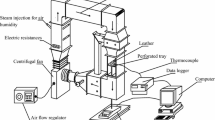Abstract
A mathematical model of synthetic leather drying for removing the organic solvent is proposed. Analytical solutions are obtained for a number of problems of heat transfer in a plate, including the problem of a moving evaporation front. The model proposed adequately describes the real processes.
Similar content being viewed by others
REFERENCES
Pokrovskii, A.A., Pochivalov, K.V., Lipin, A.G., et al., Removing the Organic Solvent from the Base of Artificial Leather at the Water-Vapor Point, Izv. Vyssh. Uchebn. Zaved., Khim. Khim. Tekhnol., 2001, vol. 44, no. 1, p. 138.
Kartashov, E.M., Analiticheskie metody v teorii teploprovodnosti tverdykh tel (Analytical Methods in the Theory of Heat Conduction in Solids), Moscow: Vysshaya Shkola, 1985.
Lyubov, B.Ya., Teoriya kristallizatsii v bol'shikh ob”emakh (Theory of Crystallization in Large Volumes), Moscow: Nauka, 1975.
Author information
Authors and Affiliations
Rights and permissions
About this article
Cite this article
Zueva, G.A., Blinichev, V.N., Pokrovskii, A.A. et al. Mathematical Model of Synthetic Leather Drying. Theoretical Foundations of Chemical Engineering 36, 365–369 (2002). https://doi.org/10.1023/A:1019803900994
Issue Date:
DOI: https://doi.org/10.1023/A:1019803900994




